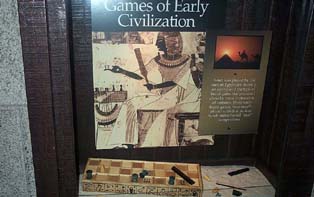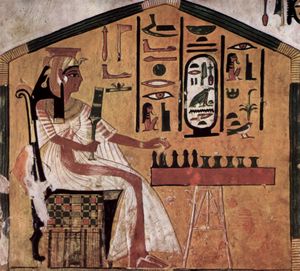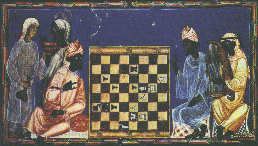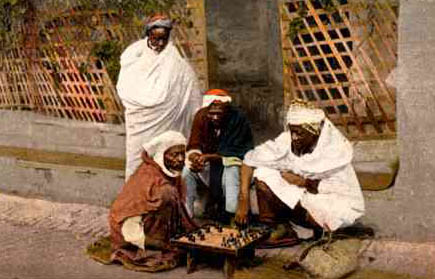African Origins of Chess?

Exhibit at U.S. Chess Hall of Fame on the ancient Egyptian game, Senet.
Copyright © 2001, Daaim Shabazz.
Dr. Joseph Bailey, II has recently penned an article titled, “Chess Originated in Africa.” We have all heard this before, but let us be specific! For example, Bailey states in his essay,
But Western literature admits that the origin of Chess is uncertain. Whenever such a statement is made, experience has taught me that the uncertainty most likely indicates it originated in Africa.

First, we know that Western literature is not always the most reliable source for many reasons. Asian literature records the existence of ancient forms of chess, but I will agree that the origins of chess (as a concept) are unclear. Most accept the notion that the ancestor to chess (that we play today) was created in India and was called “chataranga.” It then traveled westward to Persia where it became “chatrang.” It was then recorded that the Arabs learned if from the Persians after which the name took the Arabized form of “shatranj.” The name of the pieces were: shah, firzan, faras, fil, rukhkh and baidaq. (see this link!) Bill Wall, who is based in the U.S., cites Asian literature discussing the orgins of chess (see his catalog here).
Second, we cannot always assume that all art forms were created in Africa unless we are very specific about the claims we are making. Dr. Bailey makes reference to the ancient Egyptian game of “Senet.” Senet does bear a striking resemblance to “modern-day” chess, but appears to come from a different lineage. As I understand it, Senet was more of a “race” game with the moves determined by randomization. Below is a painting of Queen Nefertari (1295-1255BC) playing Senet. When traveling to Egypt, I did not see this painting of the famous African Queen, but it is quite revealing.

Queen Nefertari of Egypt playing Senet.
Third, the game played today most likely traveled across the Sahara in caravans and finally taken into Spain by the African Moors during their 800-year rule. A better question would be whether the Moors took a different form of game into Spain than the version that came from the Indian subcontinent. All literature seems to state that it was indeed, “shatranj.” The shatranj board can see below. Some versions probably had less defined features (due to religious restrictions) as pictured here.

Moors playing Shatranj in Castile, 1283AD.
I actually own a set up books on chess set collections and author Dr. Ned Munger gives some history of ancient sets. There would be an interesting history to be learned by how chess sets evolved as the game traveled from region to region. I saw the board game “Senet” in Cairo’s Museum of Ancient Egyptian Antiquities years ago and took a picture of it. The game is also featured in the U.S. Chess Hall of Fame (see top picture). However, there were many different forms of “chess” created in many different lands and many have similarities. Of course there are the Chinese form of chess called “Xiang Qi” and the Japanese form of “Shogi.”
There were other forms played with dice and thus condemned by Muslim clerics as a “game of chance.” Of course, clerics have revised their opinions of this over the years and chess is not considered “haram.” Around 700 AD, Sa’id bin Jubair was a famed African player who gave up his judgeship to pursue blindfold exhibitions. Besides the versions coming from the Arabian penisula, there are also the African chess game of “warri” played with beads. “Chess” is actually a generic name for strategic board games, but it has become associated with the game we play. Note the picture below:

This photo was from an 19th century postcard with a French caption reading “Algers–Negres jouant aux Echecs” meaning “Algiers–Moors playing Chess.”
I wrote in a essay on this photo:
The undated postcard is loosely translated “Algers-Blacks playing chess.” Of course, in French “échecs” does not necessarily refer to “chess,” but could refer to other board games such a warri, ayò, or draughts. Pictured are four men playing what looks like a precursor to contemporary chess. However, the board men appear to be the same height, dark colored and positioned on alternating squares… likened to checkers or its precursor, “el-Quirkat.” Perhaps the game being played was a variant of “Shatranj.” More important is the point of these men showing utmost erudition at a board game requiring strategic execution.
As you can see, there are African origins in forms of chess. The Moors in the above photo are perhaps playing a variant, or it may be related to shatranj, the form taken into Spain by the Moors. Once the Moors (also “maure,” “moro,” “morisco” translated as “black,” or “very dark”) were driven from Spain, the game was remade.
More research has to be done, but of course much of the Moorish literature was burned after the Moors were driven from Spain. In this literature could have been found the origins of modern-day chess. In all, I believe we have to be clear and specific about making claims of African origins of “chess” unless we are talking about a specific version. Hopefully this will clarify some of the issues and begin a discussion.

Perhaps the various forms discovered in separate parts of the world are merely a reflection of how diverse cultures manifests the spirit or essence of the struggle, which is a universal condition. Chess then may simply be another way of representing the philosophical ideas of Hegel and Nietzsche in regards to the “will to power.”
“First, we know that Western literature is not always the most reliable source for many reasons.” This is an ignornant and racist statement, which you neglect to back up. Can the same be said about Asian literature? Or African literature? Of course, you don’t persue these lines of questioning. It seems to me that you’re mostly concerned with taking a swipe at whitey. Real classy, sir.
Also, how can you bash “Western Literature” when pretty much all western chess historians ascribe the origins of chess to the Indians (e.g, Henry Davidson) or the Chinese (e.g., Sam Sloan)? Isn’t this an indication that western chess historians may be speaking the truth on this matter?
Finally, chess didn’t just make its way to Europe through north Africa. The Russians learned chess from their central Asian neighbors. The Russian word for the bishop is pronounced ‘slon’, which means elephant. And we all know that the original sanskrit designation for that piece was the elephant as well.
So much for any theory claiming that chess originated anywhere except for Asia. Q.E.D.
Actually, the first prominent European player that we all are probably aware of is Ruy López de Segura (c1540 –1580), a Spanish priest. He wrote a book outlining chess strategy. He is predated by Pedro Damiano from Portugal (1480-1544), who also wrote a comprehensive book on the game.
What’s fascinating about the Russian-Asian connection is that until they adopted the Western variants of chess in the 18th century, the Russians accepted the Asian rule that black always wins in stalemate. This was opposite to the Arab rule (taken from the Sanskrit) that white always wins in stalemate.
Also, the Russian word for rook is ‘lodya’ which means ship. The rook is called a ship in some east Asian cultures (Javanese, Siamese) as well. According to Davidson, there is much mystery surrounding this since the original Russian game was clearly given to them from the Persians or Arabs, who referred to the ‘rukh’ as a chariot. Davidson’s Short History of Chess was published over 50 years ago and is my source apart from the internet, so my source may very well be dated.
I think we can also agree that although chess entered Europe from North Africa well before it entered Russia from central Asia, the Russians adopted the centrail Asian model before they adopted the Western European model.
Damani’s point gets to the heart of the matter … our search for the single inflection point from which chess sprung forth into the world may be futile. In fact, the evidence that so called “western chess” itself is the result of a multi-cultural evolution of a game that probably didn’t even originate in the west, should motivate us to continue this investigation with open minds.
And although Daaim’s statement about the (lack of) veracity of western literature was indeed overly provocative, as called out by fasterplease, it nevertheless correctly suggests the wisdom of approaching these types of debates with a healthy dose of cultural filtering.
“First, to get to the truth you can’t start with the assumption, as Dr Bailey does, that Western literary sources should serve as your foundation. The mutli-cultural evolution of chess demands that a variety of sources be considered, with the same mix of open mindedness and circumspection.”
Okay, I don’t get it. Why are you guys being skeptical of Western chess historians? These are the very folks who attest that chess didn’t originate in the West but in India (or in the case of Sam Sloan, in China). They’re not making these claims because of some cultural bias or axe to grind. They make these claims because that is where the evidence leads them. Henry Davidson’s Brief History of Chess (Greenburg Publishing, 1949) has a three page bibliography with 66 entries. It is a well-researched and organized short work of history. In fact, Davidson takes pains to refute varying claims that chess originated in the West. And if you don’t believe him, you can check his sources or evaluate his arguments. There are no secrets. As a result, he shouldn’t be mistrusted in any way because he is Western.
Now, Daaim’s point is that the contributions of the Moors to the development of chess may be understated or to some extent ignored in Western chess literature. I don’t know if this is true, but frankly I doubt it. If there were Moorish texts available, historians of all stripes would discuss them just as they discuss early Arab chess literature. Names such as as-Suli, al-Lajlaj, Ibn an-Nadim, al-Adli, and ar-Razi are not Western but are known by all chess historians because they were important figures in chess. Race, religion and culture has got nothing to do with it.
It seems to me that there just aren’t many Moorish chess texts available. Whether they were mostly destroyed, have yet to be found, or were in small number to begin with has yet to be determined. In the meantime, please don’t knock Western chess historians. Like most historians, they do the best they can with the little evidence they have.
When it comes down to it, I disagree with your reluctance to admit the prominence and paramount importance of Western chess historians. Without the work of Western chess historians, our knowledge of the history of the game would be quite paltry since the West has produced the greatest number of chess histories. For example. Harold Murrary spent 14 years compiling his 900 pp History of Chess nearly 100 years ago. Has any non-Western historian taken such pains to chronicle chess? And Murray was by no means the first nor the last. There may be chess texts scattered about the Hindu, Persian, Arab, and Moorish worlds, but are these true histories? Are they works of scholarship? Do they exist today in any other form but as artifacts?
What this boils down to is that, if anyone wishes to learn about chess history, they should study mostly Western authors because Western authors comprise the majority of chess scholarship. This isn’t cultural bias. It’s fact.
On the other hand, your fascination with the Moors of Spain and their chess seems well founded. It would be interesting to know what they were able to do before the Reconquista. It’s also a shame that the Spanish with their Inquisition did their best to destroy the remnants of such a flourishing culture. Maybe one day we’ll learn more about them.
Well, I guess we agree on certain points and disagree on others. I enjoyed the exchange.
re. “CHESS, Iranian or Indian Invention?”
By: Shapour Suren-Pahlav
AGAIN! Again I find this Shapour Suren-Pahlav passing on the work of the late Spanish chess historian Dr. Ricardo Calvo as his own! Give credit where credit is due, kind sir. The eyes of chess are everywhere and the original item is here:
https://www.goddesschess.com/chessays/calvofacts.html
… a matter that I can vouch for personally since it has been my pleasure to meet with Dr. Calvo and actually perform English editorial services on his behalf. In fact, regardless of whatever good intent may have accompanied your submission of “some important facts” to this discussion, there exists an entire group of European chess historians who would take similar exception to your misguided appropriation of this work.
Secondly, voluminous and badly indexed as it is, H.J.R. Murray’s “A History of Chess” has come under repeated fire from modern chess and board games historians not only on the basis of specific errors in etymological attribution, but also for having been a flattering work of British colonial propaganda. Wim van Binsbergen and many others find much of what is available in Murray lacking in several crucial areas of study and bemoan the fact that they must continually address Murray’s shortcomings in order to vault past him.
Despite the canonic fervor of his modern day supporters, Murray is not the “gold standard” he was once thought to be and much wind has been taken out of his sails by researchers such as von Bimsbergen, Joseph Needham, David Li and Dr. Calvo – to name just a few. If it had been seriously concluded that Murray held all the trump, their scholarly works would have been deemed unnecessary.
As it is, the search for a definitive “origins of chess” continues to unearth new archaeo-historical information that Murray underestimated, misunderstood or even misrepresented. While it is understandable that more recent discoveries eluded him, some items well within range of his revised study suffer from omission. For instance, his well known aversion for what Pavle Bidev’s esoteric analysis revealed about chess – indeed his wholesale disinterest in esoterica and divination principles implicit in the structure of chess and many older games thought to have contributed to the eventual formation of both two and four player dice chess and chaturanja – including discrepancies shown in Partlett’s work on chess variants – expose severe weaknesses in his theory.
Despite or perhaps even because of Murray, the search for the origins of chess goes on. Aside from Chinese and Arabic chess lobbies, there are also contenders like J.L. Cazaux and the IGK group who approach the origins of chess from a less dogmatic point of view. Even British scholars such as the late Ken Whyld were critical of the British “chess from India” school. Overlooking a wider context, the Western view of history in general often tends towards narcissistic if not propagandistic ends and cannot be taken for granted on face value alone. No doubt the same can be said for many other versions of history – a chief factor that makes dissent is not only possible though comparative analysis but also desirable – regardless of whose icons suffer in the final analysis. As such, I am hardly taken aback when such things as Bernal’s “Black Athena” provoke a howling rage from those most deeply invested in maintaining the whitewashed fiction of Western superiority. Also significant – having endured the “Sir William Jones” syndrome long enough, Hindu nationalists are only now making a concentrated attempt to wrest their cultural heritage from the hands of Western interlopers.
In parallel fashion, the historical background of Berber and Moorish culture did not benefit from Spanish imperialism any more than the Phoenician-Carthagenian or the Egyptian benefitted from Rome’s imperial gambits. As for the “origins of chess”, one only has to glance at the chess-like structure of the traditional Berber women’s alphabet or Dogon representational artwork appearing on the walls of tribal council quarters to get a glimpse of certain historical possibilities latent in North African and other Mediterranean strains of culture – a pathway that does not exclude Cadiz, Don Brunet y Bellet’s Egyptian thesis, or the Spanish school of chess history we find underrepresented in Murray. Unlike the Procrustean bed supplied by some theorists, it is not due to any arbitrary pruning of back of untidy details that dedicated researchers such as Ned Munger are given to suspect a significant Afro-Egyptian strain in the “genealogy” of chess. My personal inclination and that of the Goddesschess Partnership is to keep all options open in order to allow the real DNA of chess emerge from the ashes of time and timelessness. Anything less would seem to promote the same kinds of methodological insufficiencies that have resulted in so many centuries of unwarranted culture conflicts – the diffusion of chess and its historical genesis being highly symbolic – if not directly symptomatic – of perceptual fragmentation and undue historical buttressing of ethnocentric rivalries the world at large can no longer afford to sustain.
D. McLean
webmaster
goddesschess.com
Perhaps an apology is due to Daaim Shabazz. The real culprit is Shapour Suren-Pahlav – who does not acknowledge his source – which is none other than Dr. Ricardo Calvo. Others might fall unsuspectingly into this Internet trap and therefore deserve the benefit of the doubt. On the other hand, in this particular instance, Shapour Suren-Pahlav deserves to be exposed as a blatant plagiarist.
Just a quick correction –
“Partlett’s work on chess variants” – that was DB Pritchard who wrote “The Encyclopedia of Chess Variants”. Clearly, chess is both the game we know today as well a large number of alternate “universes”. In particular, the pawn’s promotional epic and a few other standbys – such as the knight typical move – present a long term picture of successive board game permutations and a final incorporation – which, as Pritchard states, appears to have been lost in the mists of time.
Among the more conspicuous aspects of chess and board games history, the fact that there exist few (if any) solid attributions for the design of any specific boards or their pieces – no actual personalities other than the very mythical to cite – suggests a deliberately hidden hand involved in their construction. There are probably several reasons for this noteworthy tradition of avoidance – which I would lay at the feet of the classical “vizier’s game” and the vizier’s near instinctive gift for religious and political propaganda. Modern day historians are continually being frustrated and outfoxed by the older foxes.
a bientot
DMc
Thanks DR.D for this Knowleage 😆
Well i will say most people will agree with you.
Re: CHESS, Iranian or Indian Invention?
By: Shapour Suren-Pahlav
Unfortunately sometime ago by a simple mistake the above mentioned article (CHESS, Iranian or Indian Invention? By Shapour Suren-Pahlav) and “The Origin of Chess: SOME FACTS TO THINK ABOUT” by Ricardo Calvo were confused with each other upon publication by our website. Although both titles were correct, the body of texts were published in the wrong pages – i.e. Ricardo Cavalo’s body of text was published in Suren-Pahlav’s page, and vice-versa.
The mistake was later rectified but unfortunately “Iran Society” and one or two other Iranian websites have obtained a copy from our site before the correction in early 2000. Iran society and others are now being informed of the mistake and asked for it to be rectified.
Correct versions of the both mentioned articles can be accessed by visiting: https://www.cais-soas.com/CAIS/Sport/chess.htm and https://www.cais-soas.com/CAIS/Sport/chess_calvo.htm
In addition there a very good article titled “The Games of Chess and Backgammon
in Sasanian Persia” by Professor Touraj Daryaee, was also published by CAIS (https://www.cais-soas.com/CAIS/Sport/chess_backgammon.htm), which would be beneficial to your discussion here.
My Sincere apologies for any confusion.
Kind regards
Jennifer Schneider
CAIS Webmaster
Thank you for clarifying those points, Jennifer. Apologies accepted! Mystery solved!
a bientot
DMc
It is my believe that the great contributions Africa gave to the world has been deliberately destroyed and or erased. As we Africans re-discover our stolen history and reclaim it, we meet the acknowledgment with fierce resistance. We know that Western scholars has been known to lie about certain findings and paid by the government to write as being trues, or facts. Same with other cultures. When Africans and people of African descent begin to write our own history, we are confronted as being Afrocentric. It is true every time these western scholars don’t want to make the connection to African they come up with “we don’t know who started it or who built it. May be aliens!!! Our history is lock up in western and Arab museum in which the Arab call their history such as in Egypt.
I found this page after doing a Google search about the origin of Chess. (I was making a dumb unnecessary joke about the rule that states white pieces move first ). Right before seeing this search result, I saw that the origin was said to begun in India. Now, I am far too curious.
Now, it isn’t an unheard of phenomenon for two separate people creating the same thing relatively at the same time.
(Ex. “Dennis The Menace” was invented by two different artists (one in U.S. and the other in U.K.) with no relation to the other, on the same day. ).
Could this be a just a case of minds thinking alike? What are the odds?
Could this be a just a case of minds thinking alike? What are the odds?
Very slim.
There are many versions of “chess” around the world, but most appear to be variants. The real question is the origin. Some say that chess began in Persia. Many say India. Others say that because Africa’s Senet looks like chess, that it must be the forerunner. What is unclear is how it was dispersed.
You’ll have to read the comments in the above discussion.